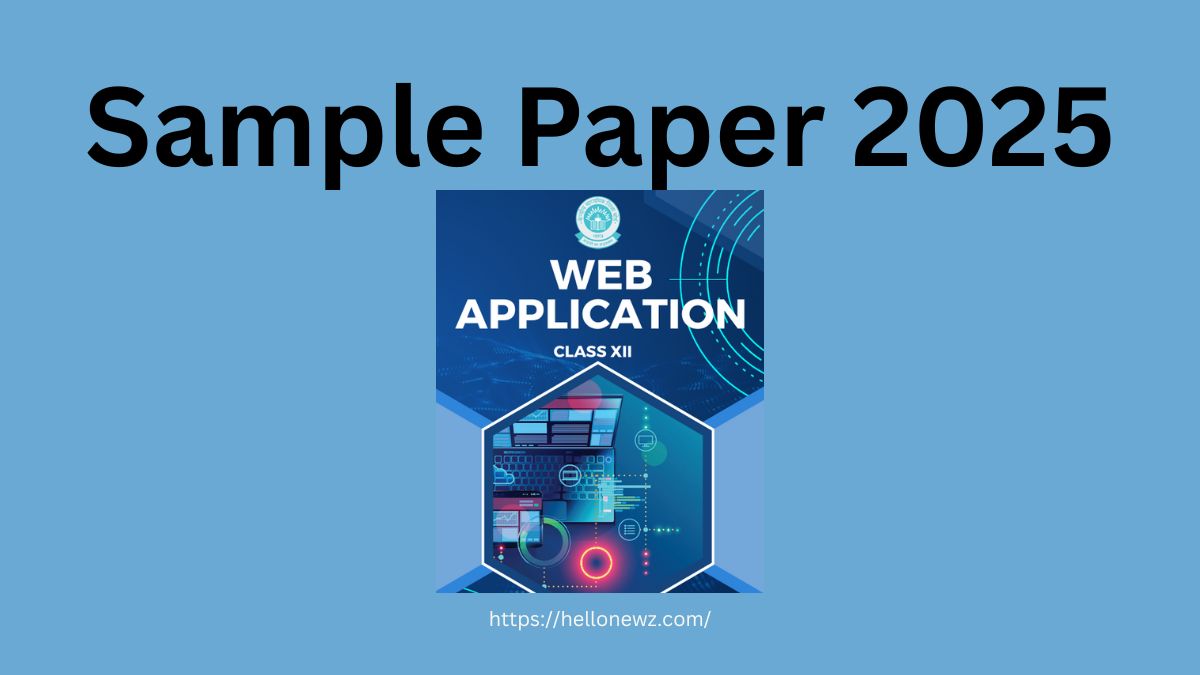Explore this CBSE sample paper Class 12 on Cyber Safety and Security, featuring 50 important questions and answers based strictly on the textbook. Ideal for students preparing for the Class 12 Web Application exam.
CBSE Sample Paper Class 12, 2025 Chapter 4: Cyber Safety and Security
50 Important Questions and Answers Based Strictly for CBSE board exam
1. What is the meaning of cyber safety?(2 Marks)
Cyber safety refers to the safe and responsible use of the internet to ensure personal and data protection from online threats like cyberbullying, phishing, or identity theft.
2. Define digital footprint. Why is it important? (3 Marks)
A digital footprint is the trail of data a person leaves while using the internet. It includes websites visited, emails sent, and information submitted online. It is important because it forms a permanent record that can affect one's privacy, reputation, and even job opportunities.
3. Differentiate between active and passive digital footprints.(3 Marks)
Active footprints are created when users intentionally share data (e.g., social media posts), while passive footprints are collected without user knowledge (e.g., cookies tracking website visits).
4. What steps can you take to reduce your digital footprint?(3 Marks)
- Avoid oversharing on social media
- Use privacy settings
- Delete unused accounts
- Use search engines that don't track users
5. Explain the term data privacy.(2 Marks)
Data privacy means the right of individuals to control how their personal data is collected, used, and shared.
6. State any three ways to ensure data privacy.(3 Marks)
- Avoid using unsecured websites (http)
- Use strong and unique passwords
- Be cautious about granting app permissions
7. What is data security? How is it different from data privacy?(3 Marks)
Data security refers to the protection of data from unauthorized access and corruption. While data privacy is about who can access the data, data security is about protecting data from threats.
8. Mention three tools or practices used for data security.(3 Marks)
- Firewalls
- Encryption
- Two-factor authentication
9. What is intellectual property?(2 Marks)
Intellectual property (IP) refers to creations of the mind, such as inventions, literary works, and symbols used in commerce. IP laws protect these creations.
10. Define plagiarism with an example.(2 Marks)
Plagiarism is copying someone else's work or ideas and presenting them as your own without giving credit. For example, using a paragraph from a website in your project without citing it.
11. What are copyrights and how do they protect creators?(3 Marks)
Copyrights give the creator of original work the exclusive right to use and distribute it. It prevents others from copying, modifying, or selling the work without permission.
12. Explain the purpose of trademarks.(2 Marks)
A trademark is a symbol, word, or phrase legally registered to represent a company or product. It helps distinguish it from competitors and builds brand identity.
13. What is a patent? How does it benefit inventors?(3 Marks)
A patent is a legal right granted to an inventor, giving them exclusive rights to make, use, or sell their invention for a certain period. It encourages innovation by protecting inventors.
14. List and briefly explain any four types of cyber crimes.(4 Marks)
- Phishing:Trick users to give away personal data via fake websites or emails.
- Hacking:Unauthorized access to systems to steal or modify data.
- Cyberbullying: Using digital platforms to harass or threaten others.
- Identity Theft: Using someone's personal details to commit fraud.
15. What is cyberstalking and how can it affect individuals?(3 Marks)
Cyberstalking is repeated use of electronic communication to harass someone. It can lead to emotional distress, fear, and mental trauma.
16. How can malware affect a computer system?(2 Marks)
Malware can damage files, steal information, or allow hackers to control the system remotely.
17. Give two examples of cyber crimes related to financial fraud.(2 Marks)
- Online banking fraud
- Credit card information theft
18. Explain any three safety measures to protect against cyber threats.(3 Marks)
- Use antivirus software
- Avoid clicking on suspicious links
- Regularly update software and apps
19. What is the role of firewalls in cyber security?(2 Marks)
Firewalls monitor incoming and outgoing network traffic and block suspicious activities, acting as a protective barrier.
20. Why is password safety important and how can it be maintained?(3 Marks)
Strong passwords prevent unauthorized access to accounts. Tips include using a mix of characters, avoiding common words, and updating passwords regularly.
21. What is the need for cyber laws in India? (2 Marks)
Cyber laws help protect individuals and organizations from online threats by legally addressing cybercrimes like hacking, data theft, and fraud. They ensure that cyberspace is regulated and users are held accountable for their actions.
22. Mention any two cyber laws available in India.(2 Marks)
- Information Technology Act, 2000
- Indian Penal Code (IPC) sections related to cybercrimes
23. How do cyber laws help in data protection?(3 Marks)
Cyber laws enforce penalties on individuals or entities that misuse or steal data. They mandate companies to follow data protection protocols, provide transparency, and report breaches.
24. Explain the punishment for cyberstalking under Indian law.(2 Marks)
Cyberstalking is a criminal offense under Section 354D of the IPC, which can lead to imprisonment and/or fines depending on the severity of the crime.
25. What is the significance of the IT Act, 2000?(3 Marks)
It is India's primary law dealing with cybercrime and electronic commerce. It recognizes electronic documents, provides legal recognition to digital signatures, and penalizes cyber offenders.
26. Write steps to report a cybercrime in India.(3 Marks)
- Visit the National Cyber Crime Reporting Portal (cybercrime.gov.in)
- File a complaint with relevant details
- Attach evidence (e.g., screenshots, email headers)
27. How can educational institutions promote cyber safety?(3 Marks)
By conducting awareness workshops, implementing internet usage policies, and including cyber safety topics in the curriculum.
28. What is the role of antivirus in data security?(2 Marks)
Antivirus software scans and removes malicious software from computers. It prevents viruses, trojans, and worms from corrupting data.
29. What is ethical hacking? How does it differ from malicious hacking?(3 Marks)
Ethical hacking involves authorized testing of systems for vulnerabilities to improve security. Malicious hacking is unauthorized and done for illegal purposes.
30. How does phishing work? What are the signs to detect it?(3 Marks)
Phishing uses fake emails or websites to trick users into providing sensitive information. Signs include spelling errors, suspicious links, and urgent requests for login info.
31. What is cyberbullying? Mention its effects. (3 Marks)
Cyberbullying is the act of harassing, threatening, or embarrassing someone through digital means such as social media, emails, or messaging platforms. It can cause emotional trauma, anxiety, depression, and lead to low self-esteem in victims.
32. How can users prevent falling victim to online scams? (3 Marks)-
-Be cautious about emails from unknown sources
- Avoid sharing personal information online
- Use secure payment gateways and verified websites
33. What is identity theft and how can it be prevented? (3 Marks)
Identity theft is a crime where someone wrongfully uses another person’s personal information to commit fraud. Prevention steps include: - Using strong passwords
- Avoiding public Wi-Fi for sensitive transactions
- Regular monitoring of bank accounts and credit reports
34. What is ransomware? (2 Marks)
Ransomware is a type of malware that locks or encrypts data on a victim’s system and demands payment for unlocking it. It can cause major data loss and financial harm.
35. Explain how to recognize a secure website. (2 Marks)
A secure website uses “https” in the URL and shows a padlock icon in the browser’s address bar. This indicates encryption and a valid security certificate.
36. Differentiate between copyright and trademark. (3 Marks)
- Copyright protects original works like books and music.
- Trademark protects brand identifiers like logos and slogans.
- Copyright is automatic, whereas trademark must be registered.
37. What do you understand by ‘Acceptable Use Policy’ in organizations? (3 Marks)
An Acceptable Use Policy (AUP) is a set of rules created by an organization to guide appropriate use of technology resources. It outlines what is permitted or prohibited when accessing the organization’s network or devices.
38. How is intellectual property protected online? (3 Marks)
- By using copyright notices and licenses
- Through digital rights management (DRM)
- Registering trademarks and patents
39. What are the consequences of breaking cyber laws in India? (3 Marks)
Violating cyber laws may result in:
- Monetary fines
- Imprisonment
- Legal proceedings and reputation loss
40. How do copyrights encourage innovation? (3 Marks)
Copyrights provide creators with exclusive rights, which act as an incentive to innovate. By protecting their work, it ensures they receive credit and potential financial rewards.
41. Explain the term cyber ethics. (2 Marks)
Cyber ethics refers to the moral principles and behavior expected while using the internet. It includes honesty, respecting others’ privacy, and avoiding illegal content.
42. Describe the responsibilities of a digital citizen. (3 Marks)
- Use technology respectfully and legally
- Protect personal information
- Report harmful or suspicious content
43. What are the benefits of using licensed software? (2 Marks)
Licensed software ensures regular updates, support, legal usage, and protection from malware.
44. How can one safeguard mobile devices from cyber threats? (3 Marks)
- Install mobile security apps
- Avoid downloading from unknown sources
- Enable screen lock and encryption
45. What should you do if your social media account is hacked? (3 Marks)
- Change the password immediately
- Inform your contacts about the breach
- Report to the platform and file a complaint on cybercrime.gov.in
46. Define digital piracy. (2 Marks)
Digital piracy is the unauthorized copying, distribution, or use of copyrighted digital content such as software, music, or videos.
47. What is the significance of two-factor authentication? (2 Marks)
Two-factor authentication adds a second layer of security by requiring a one-time password (OTP) or biometric in addition to a password.
48. How do cookies impact data privacy? (3 Marks)
Cookies store user data like login details and preferences. While they improve user experience, they can also track browsing behavior, raising privacy concerns.
49. What is the role of parental controls in cyber safety? (2 Marks)
Parental controls restrict access to inappropriate content, monitor activity, and help protect children from online threats.
50. Write three advantages of understanding cyber safety and security for students. (3 Marks)
- Helps them stay safe online
- Prevents misuse of personal data
- Promotes responsible digital behavior

